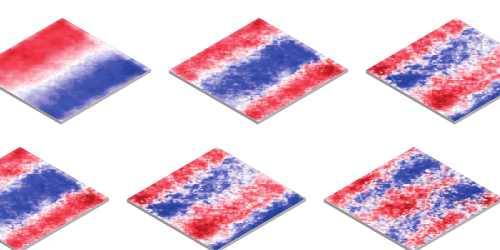Birth of Turbulence Captured for a Quantum Gas
Despite over a century of trying, physicists have yet to develop a complete theory of turbulence—the complex, chaotic motion of a fluid. Now Maciej Gałka of the University of Cambridge and colleagues have taken a step in that direction by witnessing the onset of turbulence in a quantum gas and observing its evolution over roughly 100 ms [1]. The finding could help scientists answer open questions in turbulence, which is observed in systems ranging from ocean waves to star interiors.
Gałka and his colleagues cool a collection of potassium atoms to less than 1 µK and, using lasers, compress the atom cloud into a 2D pancake. Then they excite the system so that its density oscillates at the longest wavelength the system can support—a process Gałka likens to plucking a guitar string so that it vibrates at its fundamental mode.
They find that the initial excitation wavelength quickly dissipates, with shorter wavelengths appearing as energy spreads through the gas. First these shorter wavelengths oscillate along just one axis of the pancake. But, after around 10 ms, the energy starts spreading in all directions. This change washes out the neat oscillations of the gas, and the gas’s density patterns appear increasingly chaotic as turbulence sets in.
Scientists have studied turbulence in various fluids, but Gałka notes that in most of those studies, only the final state of the system has been observable. With a quantum gas, they can capture turbulence across all the relevant length and timescales, from the very first excitation of the gas to the fully developed chaotic behavior. “Quantum gases are a relative newcomer to [turbulence],” Gałka says. “We hope that studying them can help reveal new insights into the phenomenon.”
–Katherine Wright
Katherine Wright is the Deputy Editor of Physics Magazine.
References
- M. Gałka et al., “Emergence of isotropy and dynamic scaling in 2D wave turbulence in a homogeneous Bose gas,” Phys. Rev. Lett. 129, 190402 (2022).




